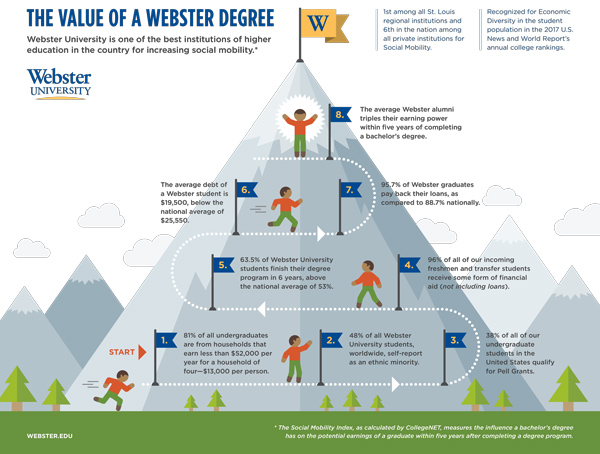Study: Accessibility, Mobility at Webster
April 13, 2017

ST. LOUIS – A new study affirms that Webster University excels in offering accessible and affordable bachelor’s degrees for students from households that earn less than the average national income. Importantly, the study concludes that Webster graduates typically increase their earning potential by securing employment that increases their income level from precollegiate levels. In fact, the University is one of the best in the country for increasing social mobility for these students.
Webster University was named the top school for “Social Mobility” in the St. Louis region and the sixth best school among all private non-profit universities in the United States, CollegeNET announced this month with the release of the third annual Social Mobility Index (SMI). The SMI is a measurement of the average graduate’s earning potential within five years after college as compared to students with similar backgrounds who do not attend college.
The study calculated an SMI for 918 colleges and universities. According to the SMI study, Webster is ranked:
- 1st among all St. Louis regional institutions
- 1st among all U.S. News institutions ranked in the Midwest Regional University category
- One of two Missouri institutions highly ranked.
- 6th among all private institutions nationally
- 60th among all institutions nationally, public or private
“This study shows that Webster is one of the best in the nation for assuring success for students whose academic talent and ambition outdistance their economic resource,” said Webster University President Elizabeth (Beth) J. Stroble. “Webster’s commitment to students takes tangible form in generous scholarships and need-based grants, financial literacy programs, and the personal attention of dedicated faculty and staff. Our investment of institutional resources, including donor gifts, fulfills our mission of meeting an unmet need.”
According to a press release about the SMI study from CollegeNET, the ability for graduates to improve their economic status after earning a bachelor’s degrees has increasingly diminished since the 2008 recession. “The 2016 SMI data analysis clearly shows that higher education’s key role in advancing economic mobility and the American Dream is rapidly deteriorating. Tuitions are increasing, economic inclusion is declining and Pell Grants – intended for students with financial need – are being awarded more generously to richer families. In fact, the 2016 SMI data reveal that at least 21.5 percent of the Pell Grants at 2,829 colleges or universities are going to students from the upper income half of our population.”
In other words, on average, most colleges accept students from affluent households and once they graduate, the average graduate will earn an early income that is comparable to their family’s average household income. There is less social mobility as a result, the SMI study concludes.
But there are noteworthy exceptions, CollegeNET announced. Webster University, North Carolina A&T State University and Granite State College in New Hampshire are named by CollegeNET as institutions that are “consistently high-ranking SMI schools that reveal a culture of access, opportunity and accessibility.”

The study says that more than 81 percent of students at Webster are from households that earned less than the national average of $52,000 per year for a family of four, and that 38 percent of students qualify for Pell Grants. The study also showed that the average Webster graduate was earning $39,800 per year within five years after completing a bachelor’s degree.
Last year, Webster University was recognized by U.S. News and World Report for “economic diversity,” a ranking that recognizes institutions with high percentages of undergraduate students receiving Pell Grants. The most recent data about Webster University shows that more than 39 percent of undergraduate students receive Pell Grants. Other factors that gave Webster a high score include its 63.5 percent graduation rate, a student loan default rate of 4.3 percent (below the national average of 11.3 percent) and an endowment of nearly $131 million.
“Webster University has never forgotten its primary mission of offering education to those who typically would not have access to it,” said Julian Schuster, Webster’s provost, senior vice president and chief operating officer. “The SMI study confirms that education received at Webster University propels students to extending their horizons, achieving higher earnings, and having a better overall quality of life after graduation.”
The SMI is computed from five variables: published tuition, percent of student body whose families are below the U.S. median income, graduation rate, reported median salary 0-5 years after graduation, and endowment to calculate the net impact an education at a specific institution would have on earnings early in a career. Data are collected from IPEDS (Federal Department of Education data) and other third party sources like Payscale, Inc. which annually surveys people in the workforce for experience and salary. The study included only alumni who have earned a bachelor’s degree but have not earned a master’s degree.
The full CollegeNET SMI can be found at www.socialmobilityindex.org.
